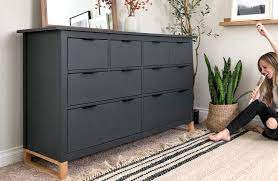It can be difficult to hang large pictures! It’s important to consider how to minimize wall damage because the wrong support could cause your picture to fall or break.
Everything you need to know about hanging a large, heavy picture on your wall is provided here. You’ll learn how to choose the best hanging support for the weight of the picture and the type of wall you have, as well as how to maintain the aesthetic appeal of your walls. Let’s get hanging!
Table of Contents
What You’ll Need
- Tape measure
- Heavy-duty hardware of your choice
- Picture hangers
- Pencil
- Drill
- Drill bit
- Level
- Screwdriver
How To Hang A Heavy Picture?
- Find the hanging point on the wall and lightly mark it with a pencil.
- Lightly mark each side of the frame on the wall after measuring the distance between the hanging point and its sides.
- Make a light mark on the wall at the distance from the hanging point to the top of the frame.
- Prepare a pilot hole in the wall that will allow the anchor to pass through with its wings folded. Drilling a tiny 1/8-inch pilot hole will make it simpler to screw in if you’re using a self-drilling anchor.
- Install the anchor, and before tightening it if you’re hanging a picture frame, make sure the hanger is through the bolt.
- Overhang the hanger with the frame wire.
- If necessary, check with a level and adjust.
Main Considerations For Hanging A Heavy Picture
When deciding how to hang a large picture, a piece of art, or any other decorative item with a heavy frame, there are many things to take into account. Various techniques and art hanging hardware can be used depending on these factors. These include the following:
1. Picture Weight
When hanging a piece of art, weight is a crucial consideration. Both the piece’s own weight and the weight of the picture frame are included in this. It would probably qualify as a heavy picture if you discover that you need assistance mounting the image on your own.
2. The Positioning Of The Pictures
Positioning is important when displaying any work of art, not only for aesthetic reasons but also for better preservation. Pictures should be placed at eye level, out of direct sunlight or heat. This is why choosing the right kind of art lighting is important, especially for priceless artwork. Consider LED art lighting designs with a range of features intended to highlight your artwork without causing any light or heat damage.
In a room, art conveys a message. Place your pictures in an appropriate location away from any obstacles or furniture since it serves primarily as the focal point. Give the piece of art enough space between it and the table or chair’s top.
3. The Type Of Wall
The type of wall you will use to hang the large picture is an important factor. Heavy artwork should be hung on load-bearing walls. It’s crucial to check that the wall has enough structural integrity to support the weight of the picture and the picture frame safely because some works of art can weigh as much as fifty pounds. The kind of fixings used also depends on the nature of the wall.
Heavy art can typically be supported by solid masonry brick walls or concrete walls. For the necessary weight support, you can drill or nail them. Screws, nails, and picture hooks are suitable for use where timber panels serve as the wall’s structural support.
4. The Picture Size And Hanging Points
You must take into account the artwork’s size and dimensions in addition to its weight. There may be a problem if you need more than one anchoring point but the picture length does not span the entire distance between the two identified wall studs because it is recommended to place your hanging points at wall studs or on the structural frames.
If this is the case, you can either choose a suitable fixing that can support the heavy weight into the drywall without a stud or choose a single heavy-duty fixing or anchor that is made to adequately support the entire weight of the artwork.
5. Picture Wire Or Picture Hook
Choose in advance whether you want to hang your picture with a picture wire or a picture hook. When hanging pictures with a wire, place the screw eyes one-third of the way up the picture frame. The hanging wire can then be tightened around the screw eyes on the left and right sides of the picture frame. Picture hooks, on the other hand, merely attach to the picture’s frame directly, enabling a more stable display.
Find picture lights for your artwork or a brick clip hanger at Perfect Picture Lights for advice from industry professionals.

6. Types Of Fixings
- Drilling and Nailing
The most popular methods for hanging artwork on solid wall structures and wooden frameworks are drilling and nailing. Drill into harder wall surfaces with a hammer drill and masonry drill bit. Aesthetically designed decorative picture hanging nails and screws with hooks allow for quicker and easier hanging. - When combined with the picture wire, a strap hanger can support up to fifty pounds when hanging a large picture. It can also be used in conjunction with picture hooks.
- The top pick in this category, however, is a sawtooth hanger because it can hold a hanging picture that weighs up to 250 pounds. On the back of the picture frame, this picture hanger frequently screws to a piece of wood.
How Heavy Can A Picture Be To Hung On Drywall?
In order to construct interior walls, typically a wood framework with a covering is used. Plaster wall was commonly used in older homes, particularly those built prior to 1940. Since drywall is the material that is most frequently used in modern homes, you will probably hang heavy pictures on it.
As a rule of thumb, pictures that weigh less than 5 pounds can be hung with hanging strips, adhesive wall hooks, or mounting tape. For pictures that weigh between 5 and 20 pounds, a good option is plastic drywall anchors and for pictures between 20 and 50 pounds, you can use a metal wall anchor or make sure to use a wall stud. Use a rail cable hanging kit to hang multiple pictures if the object being hung is heavy or as a general solution.
Hanging Pictures On Studs
The majority of the time, plaster and drywall are installed over a wooden frame. This wood is called a “stud” and it’s the strongest part of the wall. As a result, heavy frames can be hung there with ease. Having said that, not all of your studs are appropriate for hanging your pictures from a design standpoint.
How to find a stud?
To find a stud, you can use a stud finder tool. If not, just tap along the wall with your finger. When you approach a stud, the sound should change to a dud. Initially, you should hear a hollow sound. A thin nail that can support a picture weighing about 20 pounds can be used once you’ve located a stud, much like a bat using echolocation to find a fruit tree. To hold up pictures weighing more than 50 pounds, you can also use coarse-threaded wooden screws.
Using Wall Anchors
You can use drywall anchors, also known as screw-in anchors, to hang pictures on drywall without a stud.) When you need to screw directly into your drywall but don’t have access to a wooden stud, drywall anchors are the perfect solution. Your screw will be more stable and won’t come loose thanks to the anchor.
Rail-cable Hanging Kit
Using a rail-cable hanging kit is a fantastic and frequently disregarded way to hang large pictures. With this system, picture and frame hanging are accomplished by attaching cables to a rail set up along the wall. Using hooks, pictures are attached to the cables.
A rail cable’s incredible ability to support any weight (up to 300 pounds per track) is what makes it so remarkable.) You can adjust the position and height of your pictures as often as necessary, and they can be mounted on any type of wall surface, including drywall, plaster, brick, or wood.
In classrooms, homes, or art galleries, rail-cable hanging kits are ideal for hanging heavy or light frames. They only need to be set up once, and they offer a practical way to hang large pictures without nails.
Different kinds of drywall anchors are available; some are made of plastic and others of metal. For pictures weighing 20 pounds or less, plastic wall anchors are appropriate. A screw is supported on the opposite side of the drywall by two tiny legs that expand when a hole is drilled into them. Watch this video to learn how to install plastic wall anchors.
The use of plastic wall anchors for pictures weighing more than 20 pounds should be avoided as they might not support the weight. To support heavier frames, you can use various styles of metal wall anchors. For instance, a Toggle Bolt or Molly Bolt can support up to 30 pounds.
In Conclusion
The weight of your picture and the wall surface you’re using will determine how to hang a heavy picture. For light to medium-weight pictures, hanging hooks and wall anchors are effective hanging options.
However, the best way to hang heavy pictures of any weight capacity is with a rail system. You’ll have the freedom to rearrange the frames on the wall, alter their placement, or even add new ones, giving your house a unique and museum-like appearance. Additionally, your walls won’t be harmed, and you’ll have a system that works with a variety of wall decorations and will be durable and dependable for many years to come!



